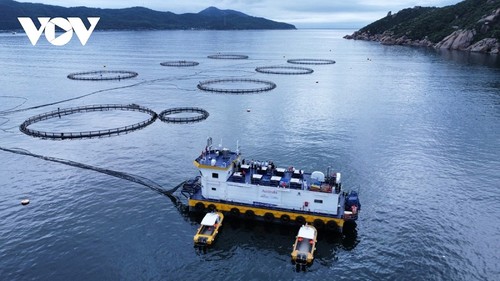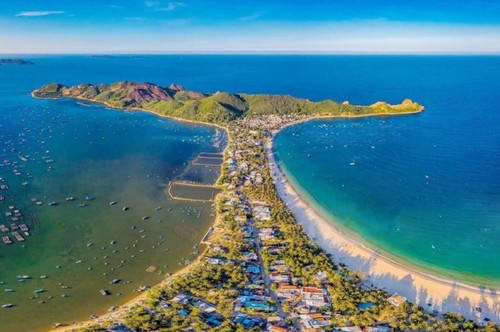 A pilot model of high-tech aquaculture in Khanh Hoa province A pilot model of high-tech aquaculture in Khanh Hoa province |
With a coastline of 3,260 kilometers and more than 3,000 islands, including the Hoang Sa and Truong Sa archipelagoes, Vietnam has a great potential to develop its marine economy. Vietnam’s maritime sovereignty and jurisdiction covers more than 1 million square kilometers. Under the Party Resolution 36, Vietnam’s marine economic sectors will contribute 10% of national GDP and its 28 coastal cities and provinces will contribute 65-70%. Vietnam’s marine economic sectors are striving to match international standards while marine resources are sustainably controlled to ensure the recovery of the marine ecosystem.
Major achievements in implementing the Resolution
Over the past five years, ministries, sectors, and localities have made strides toward realizing the Resolution. A system of aquaculture and fishing has been set up and renewable energy has been promoted.
Coastal economic zones, industrial zones, and ecological urban areas have been established. Environmental protection and responses to climate change, rising sea levels, and natural disasters have been strengthened. Localities have enhanced national defense and security, external relations, and international cooperation on maritime issues, and multiple marine economic development models have been established.
 Vinh Hoa fishing village has potential for marine economy (Photo: Phu Yen) Vinh Hoa fishing village has potential for marine economy (Photo: Phu Yen) |
Tran Hoa Nam, Vice Chairman of the Khanh Hoa provincial People’s Committee, said: "Khanh Hoa aims to develop the marine economy toward providing high-quality sea tourism and services, connecting industrial parks and economic zones with coastal urban areas, promoting renewable energy and new marine economic sectors, and making aquaculture, fishing, and processing environment-friendly. The province is focused on fishing logistics services, seaports, sea and air transport, and the sea and island economy, and has established the National Research Center for Ocean Technology."
Vietnam has paid particular attention to developing its marine economy according to international criteria for sea and ocean governance and coastal management, and has applied new technology and promoted international cooperation in marine economic development. The Government has approved a Program on capacity building and modernization of the management of natural resources and environment of national sea and islands by 2030.
Vietnam has boosted international cooperation in marine science and technology with Germany, South Korea, Sweden, and Canada as well as the UN Development Program (UNDP), the Global Environment Facility (GEF), and South Korea’s Yeosu Foundation.
Vietnam has signed MoUs with international organizations in Northeast Asia to implement the East Asia Sea Sustainable Development Strategy and the Action Plan to reverse environmental degradation trends in the East Sea and the Gulf of Thailand.
Localities in Vietnam have evaluated the potential and value of natural resources and mitigated sea pollution.
Nguyen Thai Hoa, Deputy Director of the Department of Natural Resources and Environment of Phu Yen province, said: "We’ve set specific targets for marine economic development. We aim to reduce pollution generated by fishing gear products 50% by 2025. We will reduce single-use plastics and other plastic waste in residential areas and tourist destinations, develop environmental monitoring programs to determine the source of plastic waste, and propose solutions for treatment at the source."
More efforts made to realize the Resolution
In order to more fully realize the Resolution and further promote the blue economy, Vietnam will strengthen communications, raise awareness, and create public consensus on sustainable marine economic development while strengthening implementation of the Prime Minister’s 2022 Decision on the Communication Program on Seas and Oceans until 2030.
Vietnam intends to publicize opportunities for sustainable marine economic development, clearly define the strategic role of marine spatial planning in attracting investment, and revise legal documents on the sea and island economy. Vietnam aims to ensure sufficient resources to realize Resolution 36 by reallocating the state budget and attracting more investment from domestic and foreign resources.